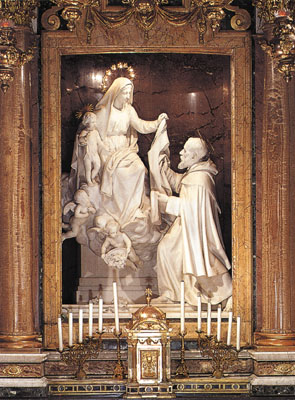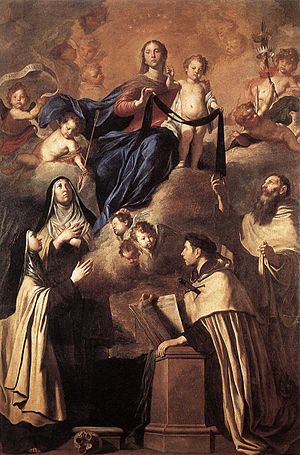 Image via Wikipedia( I'm sharing a great article about the Brown Scapular of our Lady of Mount Carmel , written by Father Kieran Kavanaugh, OCD)
Image via Wikipedia( I'm sharing a great article about the Brown Scapular of our Lady of Mount Carmel , written by Father Kieran Kavanaugh, OCD) Yoke of Christ
If we look for the earliest references to the scapular, we find them in the Carmelite constitutions of 1281 in which it was prescribed that all Carmelite friars should wear their tunics and scapulars to bed under penalty of a serious fault. It was also prescribed that the white mantle be made insuch a way that the scapular would not be hidden.
But the reason for these prescriptions was not a Marian one. At the time, the scapular was seen as signifying the "yoke of Christ." This yoke of Christ in turn pointed to obedience. And that explains the strictness of the legislation. Taking off the scapular was like taking off the yoke of Christ,or rebelling against authority.
Only gradually did the scapular take on a Marian tone and grow until it reached such a point that it became identified with Carmelite piety toward Our Lady. In fact the feast of Our Lady of Mount Carmel began to be called the scapular feast.
Devotion to Mary expressed by wearing the brown scapular seems to be resilient and resists the attempts made in various periods of history to diminish its value. The faithful keep coming back to it.
From the official teaching of the Church, we can gather that the scapular of Carmel is one of the most highly recommended Marian devotions. This is true through the centuries, and into our own times with popes Paul VI and JohnPaul II.
Sacramental
One of the early Carmelites in his enthusiasm went so far as to call the scapular a "sacrament." Actually the category into which the scapular fits is that of a sacramental.
Sacramentals are sacred signs. The scapular is what is called a conventional sign. In the case of a conventional sign, the meaning is assigned to the object from outside. Thus a wedding ring is a sign or pledge of mutual love and enduring fidelity between two spouses. In this kind of sign, which is a conventional sign,there has to be an intervention from outside that establishes the connection between the object and what it represents. In the case of sacramentals, it is the Church that determines the connection.
Sacramentals also signify effects obtained through the intercession of theChurch, especially spiritual graces. The sacramentals -- as holy pictures or icons, statues, medals, holy water, blessed palm and the scapular -- are means that dispose one to receive the chief effect of the sacraments themselves, and this is closer union with Jesus.
St. Teresa of Avila for example speaks in her life about holy water and the power she experienced that this sacramental has against the devil. She mentions as well how this power comes not through the object in itself but through the prayer through the prayer of the Church.
Along with the sacraments, sacramentals sanctify almost every aspect of human life with divine grace. The passion, death, and resurrection of Christ is the source of the power of the sacramentals as it is of the sacraments themselves.
Such everyday things as water and words, oil and anointing, cloth and beeswax, paintings and songs are ingredients of the sacraments and sacramentals. The Son of God became the Son of Mary. What could be more down-to-earth, more human, indeed more unpretentious, plain, and simple?
Church position
With regard to the scapular as a conventional and sacred sign, the Church has intervened at various times in history to clarify its meaning, defendit, and confirm the privileges.
From these Church documents there emerges with sufficient clarity the nature and meaning of the Carmelite scapular.
1. The scapular is a Marian habit or garment. It is both a sign and pledge.A sign of belonging to Mary; a pledge of her motherly protection, not only in this life but after death.
2. As a sign, it is a conventional sign signifying three elements strictly joined: first, belonging to a religious family particularly devoted to Mary,especially dear to Mary, the Carmelite Order; second, consecration to Mary,devotion to and trust in her Immaculate Heart; third an incitement to become like Mary by imitating her virtues, above all her humility, chastity, and spirit of prayer.
This is the Church's officially established connection between the sign and that which is signified by the sign.
No mention is made of the vision of St. Simon Stock or of that of Pope JohnXXII ( 22 - not the red 23 ) in relation to the Sabbatine privilege, which promises that one will be released from Purgatory on the first Saturday after death.
Nonetheless, the Carmelites have also been authorized to freely preach to the faithful that they can piously believe in the powerful intercession, merits, and suffrages of the Blessed Virgin, that she will help them even after their death, especially on Saturday, which is the day of the week particularly dedicated to Mary, if they have died in the grace of God and devoutly worn the scapular. But no mention is made of the "first" Saturday after their death.
If some day an historian were to prove beyond any reasonable doubt that there are no grounds to the Marian apparition to St. Simon Stock or the scapular promise, the scapular devotion would still maintain its value. The Church's esteem of it as a sacramental, her appreciation of its meaning and of the good that has come about through its pious use on the part of the faithful is all that is needed.
Gospel message
St. John of the Cross teaches that we ought not waste a lot of time and energy trying to discern whether or not a vision is authentic, but that we accept and follow it only insofar as the message is in accord with the Gospels and with what has already been revealed in Jesus Christ. Faith requires us to live with complete trust in God and in darkness with respect to seeing God or his saints.
The scapular as a sign is rich in meaning. I think that after we consider the official interpretations of the scapular, we can discover in it our own personal meaning. I like to think of it as a sign of Mary's quiet presence, for the scapular is a silent devotion.
There are no prayers to be said. It reminds us of the contemplative aspect of our Christian life. Contemplation is what our saints wrote so much about.Contemplation is an ever-deepening silence in loving presence to God. It is in this silence that God best speaks to us.
Mary is the Church's greatest contemplative. In her silence she heard those extraordinary words spoken to her by the Lord -- "Blessed are you among women." And so Elizabeth could add: "Blessed are you who believed."











